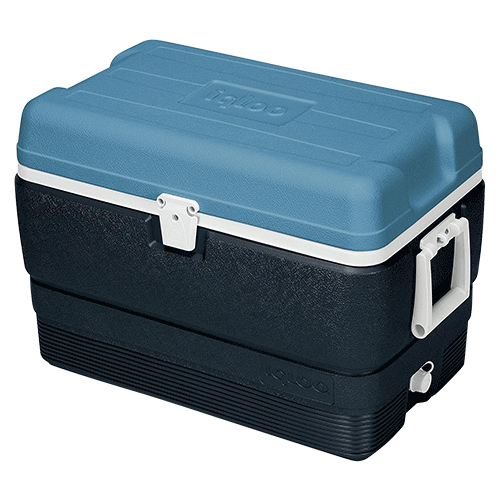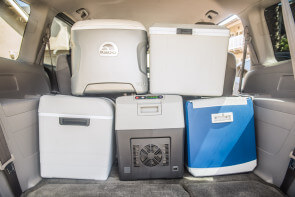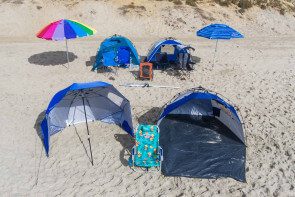
The 9 Best Coolers
We spent an entire summer prepping picnic lunches and transporting nine coolers to parks, pools, beaches and other destinations to find that the Orca – 40 Quart Classic is our top pick among the best coolers, including both rigid and soft style. The Orca kept ice the longest, has a lock-down lid and a simple design that allows for easy transportation and cleaning. For 10 quarts more capacity and a slightly higher price, the Pelican – Elite is the largest we tested and comes with lockable lid and a beefy ruler on the lid for measuring that fresh catch.
We spent an entire summer prepping picnic lunches and transporting nine coolers to parks, pools, beaches and other destinations to find that the Orca – 40 Quart Classic is our top pick among the best coolers, including both rigid and soft style. The Orca kept ice the longest, has a lock-down lid and a simple design that allows for easy transportation and cleaning. For 10 quarts more capacity and a slightly higher price, the Pelican – Elite is the largest we tested and comes with lockable lid and a beefy ruler on the lid for measuring that fresh catch.
Table of contents
- Compare the best coolers
- 1. Top pick: Orca – 40 Quart Classic
- 2. Runner-up: Pelican – Elite
- 3. Best soft cooler: Polar Bear – Solar Bear
- 4. Budget pick: Igloo – MaxCold
- Other products we tested
- How we selected products to test
- Types of coolers
- Important features to consider
- How we tested
- The bottom line
Compare the best coolers

| Product | Price | Type | Size (qts) | Weight (lbs) | Drain |
|---|---|---|---|---|---|
| 1. Orca - 40 Quart Classic | $$$ | Hard | 40 | 24 | Yes |
| 2. Pelican - Elite | $$$ | Hard | 50 | 31 | Yes |
| 3. Polar Bear - Solar Bear | $ | Soft | 48 | 4 | No |
| 4. Igloo - MaxCold | $ | Hard | 50 | 10 | Yes |
| 5. YETI - Hopper | $$$$ | Soft | 48 | 6 | No |
| 6. Coleman - Steel-Belted Cooler | $ | Hard | 54 | 19 | Yes |
| 7. AO Coolers - Vinyl Fishing Cooler | $ | Soft | 48 | 4 | No |
| 8. Coleman - Performance Wheeled Cooler | $ | Hard | 40 | 11 | Yes |
| 9. Arctic Zone - Titan | $ | Hard | 32 | 4 | No |

1. Top pick: Orca – 40 Quart Classic

In days of yore, before glamping was even a thing, it used to be hard to find a cooler that could keep ice for five days in 90+ degree weather. Now we have amazing coolers like the Orca – 40 Quart Classic. This smooth, white 40-quart cooler has a prideful simplicity, and if your camping buddies razz you about not buying the more popular YETI, you can brag about the lifetime warranty and thicker insulation.
This cooler is chockfull of thoughtful features, like a very handy Velcro pouch in the back for dry storage (even the well-equipped Pelican lacked this feature).
Though there are plenty of add-ons you can buy, as you’ll see, the Orca concentrated their efforts on what really matters: keeping things cold. We expected the Orca and the Pelican to be very close in performance (especially given the price), but the Orca outperformed its rival in nearly every category, especially when it comes to portability.
Our Top Pick: Orca - 40 Quart Classic
The Orca - 40 Quart Classic can hold the cold! Twenty pounds of ice lasted five days in blistering heat upwards of 90 °F. On top of that, the drainage system gets rid of nearly every ounce of water to keep your food dry. Plus it's easy to clean and makes for a great bench.
The Orca also cleans incredibly well, with smooth surfaces all over. We didn’t have to use any special brush to reach the nooks and crannies as we did with the Pelican. At the end of the day, the less scrubbing we need to do, the happier we are.
The 24-pound Orca uses one-inch thick rubber swing-handles that hang eight inches on each side. We all know that coordinating with another person — even on something as simple as carrying a cooler — can be difficult at times (though we got the hang of it after the first few portability tests). We found that extra room between your hands and the side of the cooler to be very useful when going up stairs or across uneven terrain. Coordination is still required, but it’s much easier with good handles.
At about an inch in diameter, the handles have an ergonomic curvature to fit your hand when carrying. This thickness works well, because you can use different parts of your forearm muscle when holding it. In other words, it’s small enough to only use your fingertips, but large enough to allow for a full squeezing grip.
Note: If you really want, you can loop your arm through so the handle rests in between your forearm and bicep, using your other arm to hold your hand for double the strength.
So you’ve easily transported the Orca to your campsite, had a blast over the weekend, and it’s time to go, but there’s water in the cooler. Not to worry, the drainage system in the Orca requires no tilt, and empties pretty much every drop due to its miniature sump area at the bottom. Just unscrew the plug and voila, dry cooler for the car ride home.
As our REI expert shared with us, one of the points of durability to look for is the latch. At first glance, the rubber whale straps seem dinky, but after feeling them for ourselves and watching this video of a bear going at it, our minds quickly changed. If they do break, however, Orca is the only company in this class that covers rubber parts under their warranty.
Key takeaways:
- The Orca – 40 Quart Classic holds ice longest in blistering heat: about four hours longer than the runner-up and 20 hours longer than our budget pick.
- Orca provides you with sturdy-yet-flexible handles that make carrying a heavy load easier.
- The tough roto-molded plastic has a clean design and is easy to maintain with a quick rinse and wipe-down.
- The drainage system is also flawless. No tilt required, and the plug can also come all the way off for cleaning. Very simple.
2. Runner up: Pelican – Elite

Pelican is a well-known name for hard-sided storage cases: For everything from cameras to rifles, Pelican is the brand to beat. After using the Pelican – Elite for a few months, we love their coolers, too.
This 50-quart cooler is the biggest we tested and kept 20 pounds of ice for just five hours less than the 40-quart Orca’s 115-hour win. The Pelican is 10 quarts larger than the Orca, seven pounds heavier and $25 more expensive on average. Pelican also falls a bit short on warranty, specifically excluding rubber feet and drain components in their guarantee of excellence.
Pelican’s lid is sturdy enough to sit on, and it has four cup holders. There’s even an angler’s ruler and cutting board to measure that freshly caught salmon and clean it.
Pelican has you covered for campground security concerns: They’ve equipped it with not one, not two, but three holes for padlocks and lock-down cables. Bear-safe, guaranteed.
Okay, you’ve caught your fish, and now it’s time to head home, but you’ve still got the worst part of unpacking: cleaning the cooler. The Pelican cleans quite easily, but there are so many non-smooth surfaces that it takes more time to wash and dry every nook and cranny than the smooth finish on other coolers. We found using a brush with about two-inch bristles worked best — firm but flexible enough to get in the harder-to-reach spots.
Something that we noticed when performing one of our cleaning tests is that the Pelican is a bit top heavy when it’s empty. For example, if you shoot the hose at the open lid, the cooler will topple over. So we just put some soap and water in the bottom first. The drainage system is second only to the Orca, with just a few ounces of water sitting in the bottom after draining.
Let’s not forget that this is a heavy duty cooler: It weighs 35 pounds when empty. There are wide, firm handles to compensate for this, so more than two people can grab hold if need be. The handle is a two-inch thick, nine-inch-wide hunk of plastic; plenty of space for two hands on each side, but they don’t swing out like the Orca’s strap-handles.
The Pelican isn’t going to be the cooler that you take to a crowded beach or anywhere else that you can’t easily pull a car up to. You can’t buy add-on wheels from Pelican, but they do make a wheeled version of the Elite that gives up some space for that convenience. Definitely consider whether the wheels are a requirement before purchasing.
After all of our tests, we prefer the Orca for carrying long distances. We know that if you’re looking to buy this cooler you probably won’t be moving around a lot (more so in a truck or boat), but it’s just something to keep in mind.
Key takeaways:
- The Pelican – Elite kept 20 pounds of ice cold for about 108 hours in 90+ degree weather.
- This is the mountain cooler, the fishing cooler. Pretty much anytime you think you’ll test the durability of your cooler, Pelican should be at the top of your list.
- Pelican has built in three padlock holes, an angler’s ruler and a bottle opener.
- It’s a bit harder to clean when compared to the Orca, but it’s sturdy and has a lifetime warranty on the plastic body.
3. Best soft cooler: Polar Bear – Solar Bear
Usually when you think of a “soft” cooler you assume it will rip or tear easily: not the case with the Polar Bear – Solar Bear. The amount of material used to keep this cooler cold and strong is pretty astonishing, and more than half of the total volume is insulation. Its double-coated 850-denier nylon is the same material used in backpacks, motorcycle jackets and boat skins, definitely outdoor-proof.
Thankfully all of the soft coolers we tested held up to their claims of being leak-proof and sweat-proof: Nobody wants to drive home from the mountains or beach with a soggy mess in the car. The Polar Bear gives you a huge opening for access, and then you can choose to buckle it down to squeeze out some air or leave it in a taller pouch shape.
At first we kept it buckled, but after a few uses we preferred keeping it unbuckled for easier access to the items inside. The shoulder strap on this bag is nowhere near the quality of the YETI, but for a third of the price, we’re okay with that. It’s still decently comfortable, and we had no problems carrying this bag on short hikes.
Something you’ll definitely want to look at if comparing the Polar Bear to the AO Fishing Cooler is the dry storage. The Polar Bear only has a small pocket, compared to about half a side of the AO.
Another bonus is that Polar Bear lets you order a customized cooler from their custom embroidery shop.
Key takeaways:
- If you want durability and ice-retention, the Polar Bear – Solar Bear is a great soft cooler for around 100 bucks.
- Its 840-denier nylon and YKK buckles and zippers should make this a very tough bag, with tie-downs for rigging to your boat or bike.
- Thick insulation holds the cold for over 75 hours, about 10 hours less than the Yeti.
- When unbuckled, its huge opening allows generous access, and the Solar Bear can be flattened down for easier packing.
- Also, the Polar Bear can be customized with a logo of your business or a family name so you never have to worry about whose cooler is whose.
4. Budget pick: Igloo – MaxCold

The Igloo – MaxCold came in third place for insulation performance, with thick walls that kept food cold for about 90 hours with 20 pounds of ice in our test. That’s not as impressive as our other top picks, but the price is only 20% of those super-coolers.
We bumped it, dropped it, slid it, and haven’t seen any damage from the wear. The polyethylene Igloo hides scratches well, and in their earlier days Igloo would test ice chest designs by lowering jeeps onto them. Igloo makes a simple cooler for a good price, nice to bring to a beach and easy to carry around.
Because the handles swivel about five inches on each side, this gives you about 10 inches of wiggle-room when transporting the cooler. So whether you’re going to the beach for a bonfire or the park for a picnic, this cooler provides great cold for its weight, is very portable and provides a great seat.
There is a strong plastic band that holds the top of the cooler from going back too far, which helps keep the hinges from taking the brunt of the weight. This, of course, is done to ensure a longer life of the hinges.
Unfortunately, you must tilt this behemoth to drain it properly, because the plug sticks out about an inch into the cooler, rather than sitting flush with the wall or bottom. That said, it still drains adequately and will do a great job for the price.
Key takeaways:
- For a classic plastic cooler, the Igloo – MaxCold is big, durable and allows for easy transportation with its well-designed handles.
- This is rugged enough to toss in the truck, and it kept ice for almost four whole days!
- If you’re looking for function over features, and you don’t want to spend hundreds on a cooler, then this is a great pick.
Other products we tested
YETI – Hopper

The YETI – Hopper is a great-looking cooler, with hard-won brand recognition among those ruggedly stylish ‘luxury camping’ people on Instagram who do yoga on top of mountains.
The strap alone feels so good in your hand and over your shoulder that you might not even care how well it keeps your ice. (that may be an exaggeration, but it did hold 20 pounds of ice for four days — about 10 hours longer than other soft coolers we tested.)
The reasons we didn’t deem the YETI – Hopper as best soft cooler were the way its zipper runs down the middle and its lack of flexibility at the opening of the cooler, which makes it difficult to pack and unpack. It’s easy enough to grab a drink, but if you’re trying to find an ingredient for your mountaintop raw-cheese avocado toast, bring a flashlight and a wish.
All soft coolers have the same problem when it comes to keeping food: The sides squeeze everything inside, so you need Tupperware to keep your food from getting squashed. If you’re really good at packing the most delicate food on top, and are extremely careful when you’re transporting the cooler, you can get by. If you’re not — as we unfortunately found out on our way to a barbecue— the shaking can turn your sandwiches soggy.
If you’re a “gear nerd,” as our consultant from REI so eloquently put it, and are sad that the YETI doesn’t have a bottle opener on the zipper pull like the Polar Bear, here’s a YETI bottle opener that attaches to the YETI’s MOLLE-compatible “hitchpoint grid.” The grid is actually incredibly useful as it allows you to attach carabiners, ropes and a ton of other compatible gear directly to your cooler.
On top of that there are multiple ways to strap this bad boy down with six D-ring tie-down points. And you can always loop through the handles, from which there are four to choose as well as a shoulder strap.
The Hopper is a cool bag, but it’s the most expensive cooler we tested. The insulation performance is impressive given the size of the bag, but if it’s mostly going to be a lunch bag (and not especially convenient to use), then we really don’t think it’s worth the price.
Coleman – Steel-Belted Cooler

Warning: If you were alive in the 70s the Coleman – Steel-Belted Cooler may elicit nostalgia. This throwback not only brings back that classic look, it can hold the cold! For four days it held the ice intact in some pretty blistering sun (hovering around 90 °F). Total time at below 40 °F is just shy of the Igloo at 80 hours. Not too shabby, Coleman.
So, it looks good, it holds the ice well … What’s the catch? Well, there’s no real catch per se, but the paint coating on the surface is pretty easily scratched. It’s also eight pounds heavier than the Igloo, so you’ll have to really love the retro style to make this worth your while.
This Coleman has a nice drain channel so that you don’t have to tilt it to empty the water. The channel is only about a quarter-inch deep though, as compared to the Orca and Pelican where drain channels are a few times as deep. But, like the Orca, the Coleman is smooth all over so all it took to clean was a spray-down and a little scrubbing. Let it air dry or wipe its surfaces with a towel, and you’re good until next year.
The metal swivel handles are a good try, giving you an extra two inches on each side to work with. However, the handles are only about three-quarters of an inch thick, which is a bit too small for a comfortable carry. You basically have to put the cooler in your fingertips and can’t really utilize your handy-dandy opposable thumbs for grip.
Coleman backs up this cooler with a six-year limited warranty, which is pretty good for hard coolers in this price range. That said, if you leave a steel cooler rusting in a boat for six years, you’re not really covered under the “defects in materials or workmanship” terms of the warranty.
Here’s something you may want to take notice of when thinking about its size and how it will fit in your trunk. The dimensions on Amazon are wrong: Instead of 25.1 x 17.5 x 17.2 inches, it’s actually 22.5 x 14.5 x 16.2 inches. So, it’s smaller in every conceivable way, which makes it easier to pack.
AO Coolers – Vinyl Fishing Cooler

The AO Coolers – Vinyl Fishing Cooler is like a vinyl half-brother to the nylon Polar Bear. The vinyl is not quite as tough as the nylon, but it never gave us pause during our testing. And, although it has less insulation that the Polar Bear, it retained the ice for almost three full days, just falling a couple hours shy of the mark at 67 hours.
The Fishing Cooler really bests its counterpart with dry storage: There is a full horizontal zipper that goes halfway up and runs across one whole side of the cooler.
We drove it to the beach for the day and back, and it neither sweated nor leaked, meaning our seats stayed dry. And on top of that, the foods we kept in the pocket stayed entirely dry as well.
There is no little bottle opener on the zipper, but it does open up a bit nicer than the Polar Bear. Another way it beats the Polar bear is that it is able to fold up smaller, about four inches thick. This makes it very easy to tuck away while it’s not in use or after all the food and beverages have been consumed.
All things considered, this is a nice soft cooler that just doesn’t quite keep up with the Polar Bear for insulation or ruggedness. At nearly the same price, we’d say the best reason to buy this is if you need it to sit in the bottom of a fishing boat for days. (The nylon used on the outside of the YETI and Polar Bear designs will absorb a little bit of water, even though the coating on the inside of the fabric will keep them from leaking.)
Coleman – Performance Wheeled Cooler

The Coleman – Performance Wheeled Cooler is that generic cooler you see everywhere: tell-tale red base, white top, wheels and big handle. It’s the one everybody seems to bring to pool parties and for good reason: It works well, and it’s less than 50 bucks. It held ice and food below 40 °F for 85 hours in 90+ °F weather. What more do you want?
Its good performance in ice-retention (fourth place) is due to its thickness (no surprise, fourth-thickest insulation). On top of the quality cold-retention, it has four drink holders molded into the plastic on the top of the lid (just like the Pelican).
This was the only cooler we tested that came with wheels (and our forearms were thankful for a break during our portability test). The wheeled Coleman was by far the easiest to transport for this reason, and you only need one person to move between picnic spots. If you do need to carry it over a rock or ravine, it has handles molded into the plastic on each side.
The handles, though, require a lot of finger strength and don’t allow for a good grip, but they are seldom needed. Even so, the good price does come at a cost: The top doesn’t stay open easily (and you feel like you’re going to break it if you push it back too far). Now, this is good for keeping in the cold (it’s hard to leave open by accident), but it makes it pretty annoying if you’re rummaging for ingredients to make a more complex meal.
It has an okay drainage system, but you still need to tip the cooler to get all the water out. Also, Coleman support reps told us on the phone that they don’t technically have any warranty for this model, though they’ll often do a “courtesy replacement” in the first year of ownership. But hey, it’s only $35.
Arctic Zone – Titan

The Arctic Zone – Titan is definitely a picnic-type cooler. It has the most uninsulated dry-storage pockets of any cooler we tested: five pockets if you count the two separate zippers in the front. It comes with a shelf that keeps things out of the ice, too. (Note that this will definitely mean your food heats up more than it would if it were submerged during a days-long trip.)
All of our dry food stayed dry during a day trip to the pool. It was refreshing to have a cooler that came with a dry shelf after our soggy sandwich incident. However, we noticed the dry storage on the outside wasn’t completely waterproof when we brought out the hose for cleaning. So, it’s “waterproof” as long as you don’t absolutely soak it. Thankfully, the shelf insert doesn’t prevent you from cooling a certain kind of 12-ounce bottle standing upright.
Okay, so great dry storage, but what about the cold-retention? It performed the poorest out of all the coolers we tested, but that’s some stiff competition! It still had ice after 69 hours in some hot, hot sun, which is more than enough cold-retention for a day-cooler. Note, however, that if you keep something like raw chicken on the dry shelf instead of submerged in your ice, it might spend a whole day above the 40-degree safe zone before it finally gets cooled down enough.
The shoulder strap is attached at a nice angle that makes for carrying it a bit easier. But, especially when compared to the strap of the YETI, it is not exactly comfortable with a heavy load. Also, there is no drainage system; you’re going to have to empty it the old-fashioned way.
Also, we noted that during our summer of tests the sun faded the black fabric. So, if you’re someone who doesn’t like the look of wear-and-tear, then we suggest going with a more UV-resistant option, like the Polar Bear.
How we selected products to test
There are a ton of reviews on coolers, but we noticed a lack of focus on testing with practical foods so we made sure to give that a go. We read through some reputable reviews like Outdoor Gear Lab’s, as well as some from Outside Online and Wirecutter. We read about the basics of cooling and ice chests and then consulted a professional.
We spoke with Ray from REI, who, having worked there three years and camped and hiked for eight years, knows his way around a cooler. When we asked Ray about the most important features, he said the most important thing for him is always insulation. Makes sense.
YETI has been making their roto-molded cooler since 2005, and when YouTubers start cutting these expensive products in half you know it might be a big deal. Orca’s a newcomer that clearly aims to compete on this turf, and their insulation is thicker and their warranty is better than YETI’s. We’re not saying YETI coolers are bad, but between Orca and Pelican we’re confident that our bases are covered.
Our expert Ray personally uses the YETI but says that his friends own Orca and Pelican coolers and have had similar rave reviews. We asked Ray what really made a cooler stand out. “Function is what matters,” he told us. “Gear-nerds want everything like attachments and bottle openers, but all you need is a cooler that keeps the ice and can hold up outdoors.”
The durability and warranties alone tell you a story of quality, and that’s where we saw the biggest difference in the products we researched. The return procedure at a retailer like Amazon or REI is pretty generous if you find a flaw in a product right away, but that doesn’t help much if a hinge fails after a summer of light use.
We then scoured Amazon for customer reviews to further narrow our selection. We finalized our selection to five hard coolers and four soft coolers to give you the best nine coolers on the market.
Types of coolers
There are really only two types of coolers: hard and soft. We have tested soft and hard small coolers, as well as hard plug-in thermoelectric coolers.
The hard cooler is the classic, usually made of plastic or steel, used for parties, boats and camping. They either have wheels or side handles. A hard cooler is the more durable, of course, if you’re throwing it in the back of a truck or the bottom of a boat.
Soft coolers are a good compromise for on-the-go activities like kayaking at the beach, or anytime that portability is more important than maintaining the ice-chest shape of a hard cooler. A shoulder strap makes a soft cooler easy for one person to carry, and you can collapse it after you’re done chilling down your food and ice.
Important features to consider
Insulation: The main function of a cooler is to keep drinks cold and food edible. For the best cold-retention, you’ll want to get a cooler with thick insulating walls and a tight seal. This means that for better performance you need to be prepared to store and transport a bigger cooler: Even though two coolers may both have an inside volume of 40 quarts, the one with thicker insulation will take up a lot more space in your car.
We checked inside volume against the outside measurements of all the coolers, and the best-performing models are nearly 70 percent devoted to insulation space, while the least-insulating cooler was only 36 percent. You can check out this chart below in the how we tested section.
Carrying capacity: What purpose do you want this cooler to serve? Is it a picnic-day cooler, a beach-day cooler, a multi-day camping cooler or another type of adventure cooler?
Generally speaking, you can fit about one-and-a-half 12-ounce cans and a good amount of ice in a quart of space. So, a giant 50-quart cooler like the Igloo – MaxCold will hold 72 drink cans for your next backyard gathering (where you can relax in comfort in a zero gravity chair). On the smaller side, then, the Arctic Zone – Titan’s 32-quart size should do the trick for 48 cans worth of a bonfire or half as much drink and a few days of perishable lunch ingredients.
Portability: Here’s where the soft coolers take the cake (though the cake may get soggy in there). You only need one person to move a soft cooler because they are lightweight and come with shoulder straps. Unfortunately, the trend of coolers has been to lose the wheels, especially with the more high-end coolers (brands like Orca and Pelican). However, you can still buy Orca wheel add-ons and a Pelican cooler with wheels.
For handles, they can be swinging or stationary. For example, the Orca uses thick fabric, the Coleman – Steel-Belted Cooler uses metal swivels, and the Pelican uses plastic handles molded into the side. During our portability test, we found it is usually easier to carry coolers with swinging handles because it gives you some leeway when walking with another person.
Overall size: If you can’t fit it in your car, what’s the point? There’s a trade-off between carrying capacity, insulation and how much space a cooler takes up.
Durability: Hard coolers tend to be more durable than soft coolers, but the really cheap plastic can crack with rough use or storage in the sun.
The soft coolers we tested all used hardy materials like nylon and vinyl (though our consultant told us nylon is more durable). The AO Coolers – Vinyl Fishing Cooler claimed to be tear-resistant up to 375 pounds; we could only get 160 pounds into the cooler, but we were very satisfied it would take anything you can throw at it.
The top two coolers we tested, the Orca and the Pelican, both have holes for multiple padlocks so that bears can’t break in. Don’t believe us? Both are certified by conservationists!
Drainage: All of the hard-side coolers we tested feature a drain except the Arctic Zone. It’s very handy to have a drainage system when going on longer trips so that you can replace ice as it melts.

If you’re using the cooler for longer than a day and you can’t replace the ice that melts with your portable ice maker, the cold water can still keep your perishable food out of the danger zone. Until the water itself gets warmer than 40 °F, it’s still helping keep bacteria at bay by absorbing heat when you open the lid.
Dry storage: If you’re transporting any food, there are only a couple options: Either get waterproof storage containers for the food or a dry storage container for the cooler.
The dry storage bin acts as a shelf to keep the top of the cooler dry. Note: You’ll have to keep the cooler level for this to be effective, so don’t expect dry food after you go 4-wheel-driving.
A couple little fun extras you can find in coolers are things like the big angler’s ruler on the surface of the Pelican. Having a bottle opener attached to the cooler proves to be very useful, since it’s not going to get lost in the dark. Cup holders are another classic feature that comes in handy on a boat. Add-on wheels are another consideration
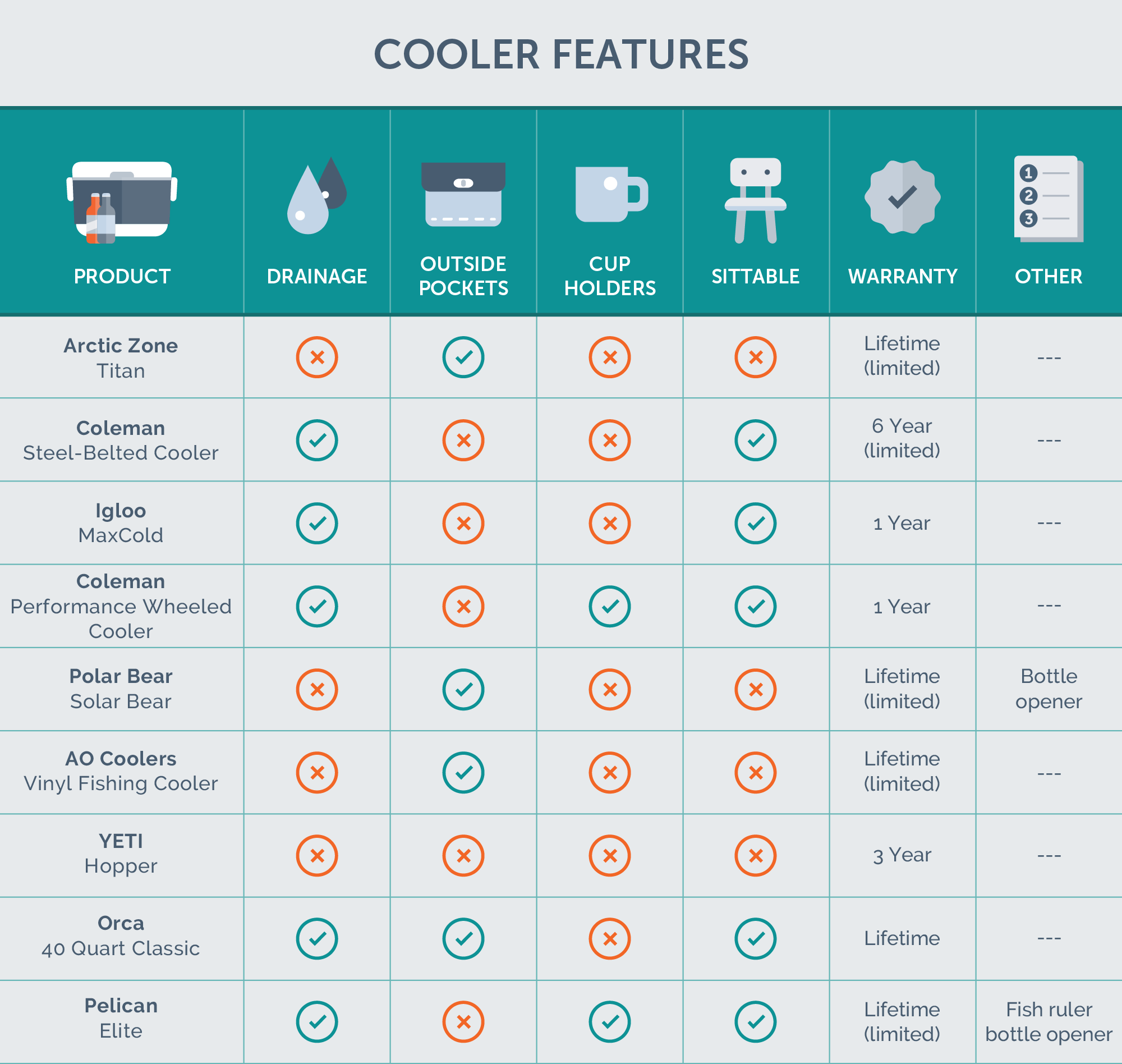
How we tested
Before we got into the more scientific approach of testing insulation, we took each cooler to multiple locations including parks, beaches and barbeques. We used them with our families and friends to get a user’s more general opinion in addition to our own, plus the information from the expert on what to look for.
We carried them over rocky terrains, flat ground and sand and got input from those who helped us. These real-life evaluations made certain aspects of the coolers easy to spot. For instance, the narrow opening on the YETI – Hopper not only makes it really hard to pack but also difficult to reach in and quickly grab an item (though it will keep things colder).
We considered which coolers needed flat ground, those that could be put on uneven surfaces when you’re camping and those that could be used as a seat. We looked at how easily all of the coolers could be loaded up, carried and cleaned (nobody wants a smelly cooler). All of the everyday use and trip uses were looked at from many different people’s perspectives.
Insulation tests
As to the science, we conducted two different “ice tests” that measured the insulation abilities of each cooler in controlled but realistic scenarios.
In the first test, we loaded up each cooler with seven pounds of ice from our army of ice makers and a Bluetooth thermometer. Nothing else was put in, minimizing variables that might skew the test.
This was just to get a baseline for an idea of how the coolers compared to one another. It is just about as simple of a test as you can run; just ice and temperature. We found that the Orca – 40 Quart Classic holds ice the best in this test, and the Igloo – MaxCold did incredibly well when we look at performance-to-price ratio.
The next test we conducted was an attempt to see what would happen to real food in real-world conditions. We simulated a typical picnic and added some raw chicken to see how long that would keep fresh on a camping trip before it needed to be cooked.
Each cooler was filled with the following:
- 20 pounds of ice
- Two 16.9 fluid ounce water bottles
- Half a pound of cooked penne pasta and raw cherry tomatoes
- Two grilled chicken breasts
- One raw chicken breast
All of the items’ temperatures were measured every few hours with an infrared surface thermometer until the ice was gone. We also had Bluetooth thermometers to measure the overall temperature inside the cooler to see how that compared to the temperature of the food and drink. (You can see the results in the graph below.)
Note that the United States Department of Agriculture Food Safety and Inspection Service (USDA FSIS) mandates 40 °F as the maximum safe temperature for storage of perishable raw food like chicken and dairy. If your ice melts the cold water will still capture some heat for a while, but once you cross the 40 °F threshold you should cook the food within hours.
Another thing to note is that the USDA FSIS safe food-handling guideline suggests keeping raw chicken in the refrigerator for only one to two days and cooked chicken for three to four days. Due to limited space in some of the coolers, the chicken was not always in the coldest spot, so it’s essential that you factor in a margin of safety for your camping trip cooking plans.
Size

Though we picked coolers with similar internal capacities, most between 40 and 50 quarts, the outer dimensions of the coolers varied quite a bit. For example, the Pelican was the biggest overall at over 9,500 cubic inches whereas the Igloo, rated for the same 50 quarts of carrying capacity, only takes up 6,700 cubic inches in your boat or trunk.
Note that the percentage of a cooler’s volume that’s devoted to insulation tracks very closely to insulation performance. There’s definitely more to insulation than just the thickness of a cooler’s walls, but fancy materials clearly don’t help the AcrticZone – Titan as much as the YETI – Hopper.

We measured both the interior and exterior dimensions with a standard measuring tape. And, just to make sure, we measured the volume in quarts by pouring water into each cooler until each was full. As you can see, the sizes and shapes vary quite a bit.
Portability
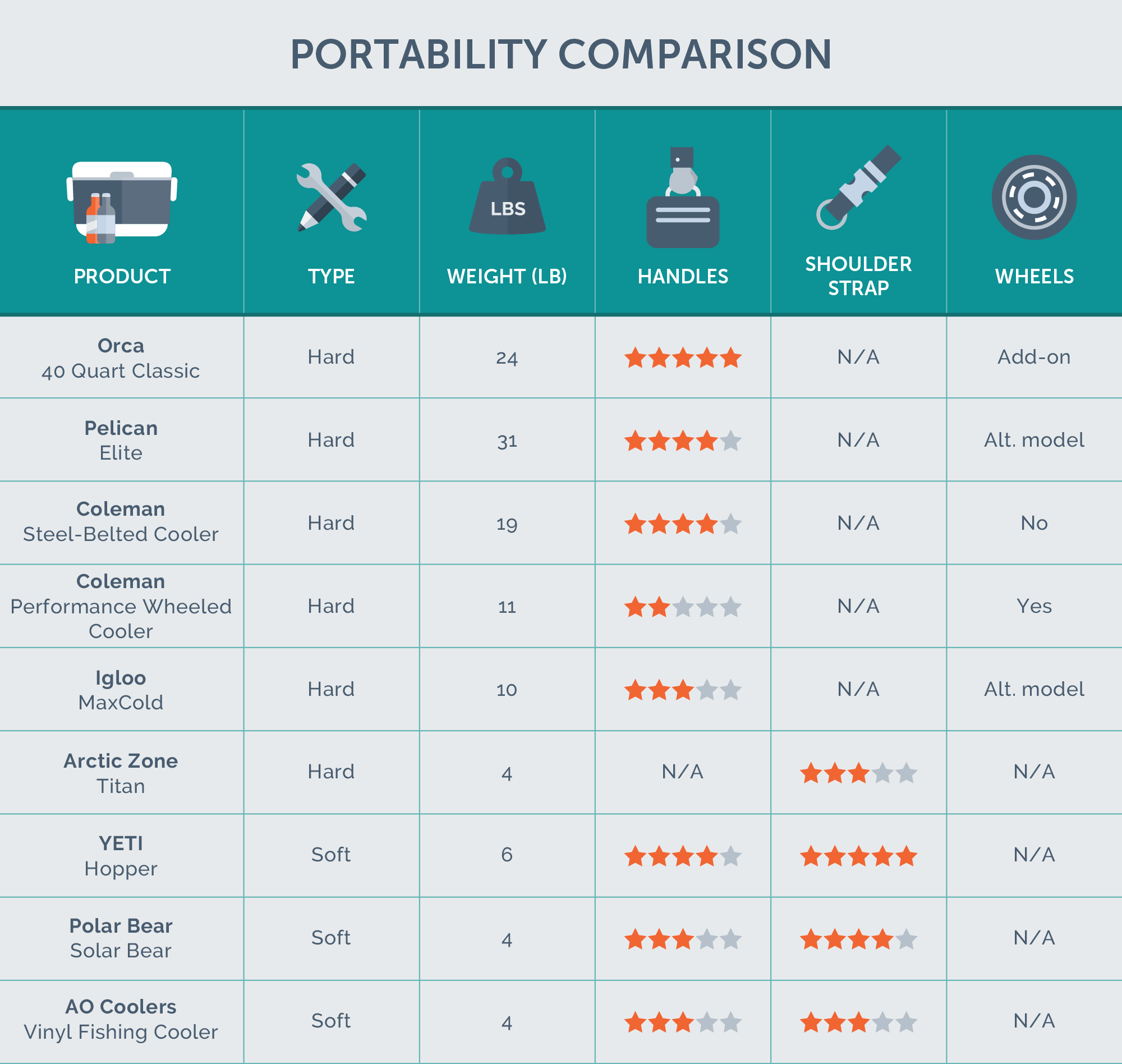
For portability tests, we loaded each cooler with 40 pounds to make it a realistic full weight. We then marked out a 500-foot test walk and (with a little help from our friends) we carried or wheeled each cooler to the point and back, which took about 5 minutes.
We did this with two people, both in-shape males in their mid 20s, as well as with just one person. After each carry, we rated how ergonomic the handles were. We could definitely feel the burn with the larger coolers (the Orca and Pelican) because they weigh about 25 and 30 pounds without any added weight.
The weight definitely plays a role in how portable a cooler is, but if you’re using a heavier cooler over a long weekend, hopefully you won’t have to move it once you make camp.
The only wheeled cooler we tested (the Coleman – Performance Wheeled Cooler) was incredibly easy to move on paved ground, so it is perfect for pool days and local events. But when we took it to the beach, the wheels did us no good, and the molded handles are just adequate.
Cleanability

We made sure to dirty up the coolers when taking them with us to our various locations. But the worst thing we did, at least in terms of smell, was leave all the food in the coolers for an extra week to make sure that they smelled terrible. What can you expect with gross raw chicken? We then threw away all the food and hosed them down, scrubbed them with dishwashing soap and used our nostrils to determine when they were finally clean (hesitantly). Other than the ribbed interior of the Pelican, we found the smooth surfaces of the hard coolers very easy to clean.
Some of the soft coolers had harder-to-reach spots on the interior, but the material from which they’re constructed made them a breeze to clean. All of the hard coolers were cleaned with a little scrubbing with a rough-sided sponge, soap and hose. They were all as easy to clean as you’d hope, and the smell was nowhere to be found!
One of the more time-consuming parts to clean was the cup holders, just because you can’t clean it in big swiping motions like you can the coolers without cup holders. Also, the Arctic Zone cooler took a bit longer to dry because it has the most fabric, which absorbs water; but we found that if you just leave it in the sun it’s fine. All of the coolers are waterproof, so that makes for great clean up.
Packing and unpacking
Unfortunately, the soft coolers are much harder to pack and unpack, especially the YETI as it has only one zipper down the middle, which only creates a small opening (about a fourth the size of the Orca).
The packability of most coolers was great. On the whole, the hard coolers scored beautifully, though the lid on the Coleman Wheeled had trouble staying open due to the plastic hinge. As far as soft coolers go, the AO and Polar Bear have large openings when they are not buckled down. The only real letdown here is the YETI; the zipper leaves little room to pack and unpack. If you’re just using it for drinks, then it’s a nonissue.
The bottom line
Whether gearing up for a weekend trip or a casual outing to the park, you want a cooler that can keep the ice cold and that’s easy to transport. We chose the Orca – 40 Quart Classic as the top cooler, because it maintained ice for more than 110 hours, was one of the easiest coolers to clean and provided the best handles for carrying.
If you’re heading to bear country or salmon streams, the Pelican – Elite will satisfy all your outdoor needs with its durable materials, built-in ruler and triple-locking lid. Fifty quarts of capacity also means you could put even more ice in there to get better than our tested 108 hours of raw-chicken-safe cooling.
If you’re going for cost effectiveness, then the Igloo – MaxCold can fulfill your quest as it performs nearly as well as the coolers in the couple-hundred-dollar range. Fifty-quart capacity, 90 hours of ice, and it’s only about 60 bucks.
Soft coolers are great for the more adventurous outings, as they can be packed down very compactly once they’ve finished their job. With 48 quarts of capacity and almost 75 hours worth of ice-keeping insulation, the Polar Bear – Solar Bear came out on top in this category, mostly because of better zipper design and a much better price than the big-name competition.
Our Top Pick: Orca - 40 Quart Classic
The Orca was pitted against the best and came out on top. Thanks to its completely smooth surfaces, cleaning couldn’t be easier, and Orca has the best warranty we've seen. With five-day ice-retention, ergonomic handles and flawless drainage, there’s little left to be desired.
More Reviews
Igloo - Playmate 30 Can
Thermos - 2700TRI6
The Best Thermoelectric Coolers
Koolatron - P27
The Best Beach Umbrellas, Chairs and Tents
Sport-brella
Garrett - Ace 250
Mac Sports - Heavy Duty
The North Face - Mainframe
AMES - 2519500
Feetures - Elite Max Cushion
Klarus - XT11GT
Specialized - Echelon II





